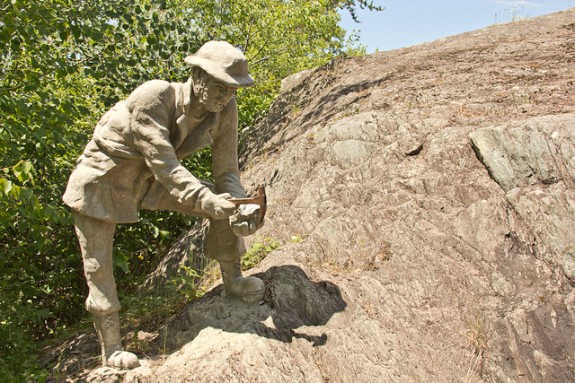Water Cut Off From the World for Billions of Years Is Bubbling From the Bottom of a Mine
1.5 miles down at the base of a Canadian mine life may have thrived

Timmins, Ontario, has a long history as a mining town. Photo: Michael Jacobs
In the small city of Timmins, Ontario, a town nestled half way between Michigan and Hudson Bay, there is a mine. Actually, there are many mines—it’s a mining town. But this story is about just one, a mile and a half deep, where there is water bubbling up from below that has been cut off from the rest of the world for at least a billion years—maybe as much as 2.6 billion years.
The longer end of that timeline, Ivan Semeniuk points out in the Globe and Mail, is about half the age of the Earth. This water hasn’t been in contact with the rest of the planet since before the rise of multicellular life.
But like the water trapped in frozen lakes below Antarctica’s massive ice sheets, researchers suspect there might be life in these flows.
“It’s been called the Galapagos of the subsurface,” says Barbara Sherwood Lollar to New Scientist. The water, “is packed with hydrogen and methane – chemicals that microbes love to eat.”
“What we have here,” says Sherwood Lollar, a microbiologist at the University of Toronto in Canada, “is a plate of jelly donuts.” While she has yet to confirm whether the water is inhabited, she says the conditions are perfect for life.
The scientists don’t know whether there is any life in the ancient, isolated water. But they’re working on it. The water is young enough that it would have been locked away after life arose on Earth. But it’s been trapped for so long that any life that does exist would likely be unique—a relic of an ancient world. The CBC:
Some Canadian members of the team are currently testing the water to see if it contains microbial life — if they exist, those microbes may have been isolated from the sun and the Earth’s surface for billions of years and may reveal how microbes evolve in isolation.
One can’t help but be reminded of the Balrog: “Moria! Moria! Wonder of the Northern world. Too deep we delved there, and woke the nameless fear.”
More from Smithsonian.com:
/https://tf-cmsv2-smithsonianmag-media.s3.amazonaws.com/accounts/headshot/smartnews-colin-schultz-240.jpg)
/https://tf-cmsv2-smithsonianmag-media.s3.amazonaws.com/accounts/headshot/smartnews-colin-schultz-240.jpg)